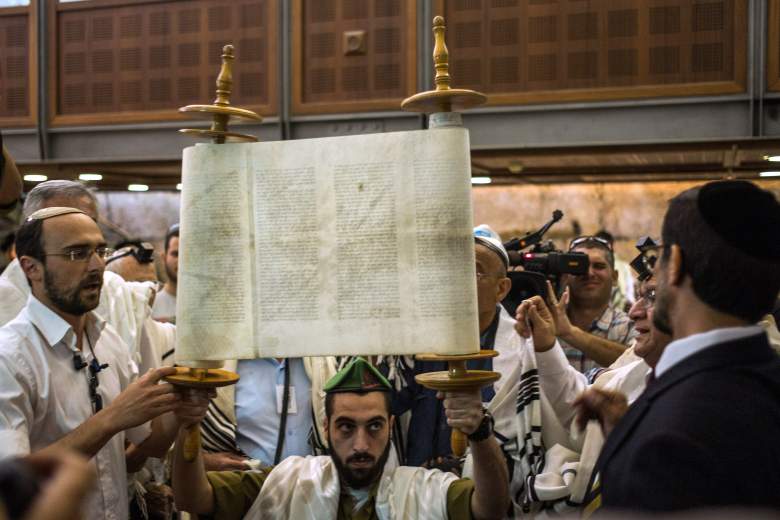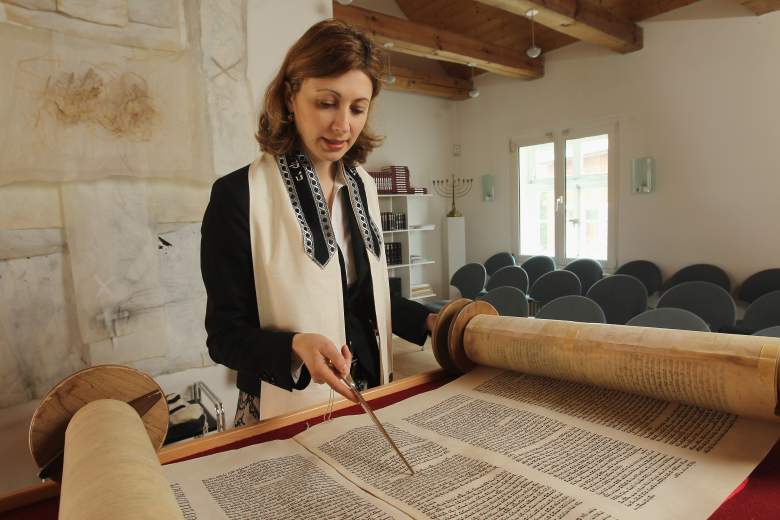
(Getty)
Shavuot begins at sundown tonight, May 30, and lasts until sundown on June 1. On the Hebrew calendar, the holiday always falls on 5-7 Sivan. That’s why the dates vary so often on the Gregorian Calendar, like many other other Jewish holidays.
The holiday is known as the “Feast of Weeks,” since its name literally means “weeks” in Hebrew. It celebrates the wheat harvest in Israel, as well as the day God gave Moses and the Nation of Israel the Torah.
Shavuot isn’t a very well-known holiday, but it is closely tied to the more important Passover. It’s part of the “Three Pilgrimage Festivals,” when ancient Israelites would go to the Temple in Jerusalem.
Here’s what you need to know about Shevuot.
1. Shavuot Marks the Completion of the Israelites’ 7-Week Journey Form Egypt to Mount Sinai
Once Moses led the Israelites out of Egypt, it was not easy for them to reach their destination. According to the Torah, it took seven weeks for them just to reach Mount Sinai, Reform Judaism notes. Rabbis believe that, at this point, Moses received the Torah from God, which is how the holiday ended up linked to that event.
The Torah does not specifically link Shavuot with this event. However, the Bible does mention a grain harvest that lasted seven weeks. It began around Passover, when farmers started harvesting barley, and ended with the wheat harvesting at Shavuot. That’s why this holiday takes place seven weeks after Passover.
“Seven weeks shalt thou number unto thee; from the time the sickle is first put to the standing corn shalt thou begin to number seven weeks,” reads a verse in Deuteronomy Chapter 16.
2. Dairy Foods Are Commonly Eaten on Shavuot
It’s tradition for Jews to eat dairy foods on Shavuot, in case you need an extra excuse to consume cheese for the next few days. As Ask Moses.com notes, there are several theories as to why diary is associated with the holiday.
First, dairy is associated with mothers’ love as they nurse their babies with milk. God showed that kind of love to the Israelites at Mount Sinai. Another theory is that the Hebrew word for milk is “chalav,” which has a numerical value of 40 – the same number of days and nights Moses spent on Mount Sinai.
Another theory is that when the Jews received the Torah, it was on Shabbat, when we are forbidden from slaughtering animals. They were forced to eat dairy because they also did not have any meat that was previously ritually slaughtered.
However, it is still mandatory to eat some meat, according to Ask Moses, because Israelites offered two loaves of broad to the Holy Temple on Shavuot. This means that we have to eat two meals – one of dairy and one of meat – during the festival.
According to Tori Avey, some Sephardic Jews also make “siete cielos” (“seven heavens”), a seven-layered cake to represent Mount Sinai.
3. The Book of Ruth Is Traditionally Read on Shavuot

(Getty)
Since we can’t go to the Temple of Jerusalem to offer our harvest, there aren’t any specific mitzvot associated with the holiday, notes Reform Judaism. Therefore, Jews can spend Shavuot in Temple, studying Torah all day and all night during the holiday.
The Book of Ruth is traditionally read on Shavuot, notes Mazornet. This is because there are parallels between Ruth’s story and the story of the Israelites receiving the Torah. As Ruth converted and was accepted by God, the Israelites also accepted God by receiving the Torah.
There are other connections between Ruth and Shavuot. Her great-grandchild, King David, was born and died on Shavuot. The Book of Ruth also take place during the harvest and shows how the Israelites treated the poor with kindness.
4. All Torahs Must Be Hand-Written in Hebrew By a Sofer

(Getty)
Making a Torah isn’t as simple as printing a book. It’s a painstaking process. Each kosher Torah must be hand-written by a sofer (scribe) who is specially trained in the art, according to My Jewish Learning. The Torah includes the Five Books of Moses – Genesis, Exodus, Leviticus, Numbers and Deuteronomy – which also make up the Old Testament.
The sofer writes the Torah out on parchment made from the skin of a kosher animal and uses a quill. After the writing is completed, the parchment pieces are then sewn together, then attached to wooden rollers. You can’t use any instrument with iron or steel to make a Torah, since these are seen as materials of war.
Even the way a sofer writes the Torah is special. The Hebrew letters look like traditional letters, but are often embellished with special crowns known as “tagin.” Sometime the font sizes vary too, and each change has a meaning. The letters don’t randomly change size so they fit in the scroll. It’s all deliberate and has to do with the content of the passage.
As The BBC notes, Jews also believe that Moses was given the oral law called “Torah she b’al” (“Torah from the mouth”).
“Although given at the same time this law was to be passed down orally from generation to generation. It is the information Jews need to practice fully the commandments in the written law. It was codified in the 2nd Century C.E.,” the BBC notes.
5. Shavuot Is Only 1 Day in Israel

(Getty)
In Israel, Shavuot and other holidays are shorter. Shavuot is only one day in Israel, but two for Diaspora Jews. As My Jewish Learning notes, this has to do with traditions going back thousands of years.
Rabbis ruled that those who live outside of Israel should celebrate holidays for two days, that way they couldn’t be confused about which day the holiday really fell on. The idea is if you celebrated for two days, there’s a 50-50 shot of celebrating on the right day.
Today, this idea seems outdated – as in over 2,000 years outdated – since we now can figure out precisely when a holiday occurs with a fixed calendar. Chabad.org notes that Jews started using the fixed calendar in the Fourth Century CE, but there is still a rule in the Talmud that we remain bound by rabbinic law to have a second day of a holiday in case some mistake is made.
